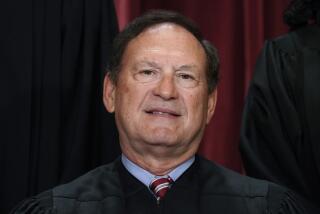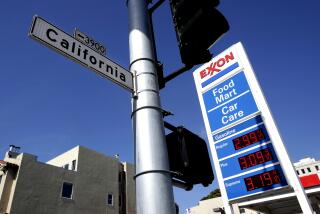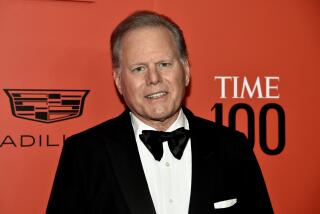Tax Talk Stokes Interest in Dividends
- Share via
In the late 1990s, a generation of stock investors came to regard the cash dividend as a quaint concept whose time had come and gone.
But 2 1/2 years of mostly falling share prices have given new life to the idea that equities should provide investors with a regular payment of cash money -- an income stream that would be there even if capital gains weren’t.
The idea may get a big boost in 2003: Wall Street is abuzz with talk that the new Republican-controlled Congress will seek to change tax laws to enhance the appeal of dividends.
Even firms that historically have been unwilling to share profit with stockholders via the payment of dividends -- including many technology giants -- could feel compelled to change their policy if Congress acts.
Last week, at computer networker Cisco Systems Inc.’s annual meeting, the company faced a shareholder resolution calling for the initiation of a dividend. The measure, opposed by management, failed by a 10-1 ratio, Cisco said.
But CEO John Chambers told shareholders that Cisco isn’t inherently opposed to paying dividends. “If tax policy were to change or if we would hear more shareholders want to do it, we always want to listen,” Chambers said. “We don’t have a religious view on dividends.”
Can small investors learn to care about dividends? Should they care? For many, it could be a tough sell. Long-term investors can argue that they don’t buy stocks for current income, and that they don’t need it in tax-deferred retirement accounts. Some may not relish having to decide how to reinvest that cash each quarter.
Dividend proponents say those concerns miss the point. If stock price appreciation is much harder to come by in this decade than the last -- a distinct possibility -- then dividend income could mean the difference between a poor return and a decent return on equities.
That may be conceptual now, but it won’t be in 2010 if investors are looking back and asking why their portfolios haven’t grown.
“A dividend,” said Charles Carlson, editor of the dividend-focused DRIP Investor newsletter in Hammond, Ind., “is a bird in the hand.”
History shows that in the 1940s, 1960s and 1970s, a large portion of the average annual total return on blue-chip stocks came from dividends.
In the 1960s, for example, the average total return on the Standard & Poor’s 500 index was 7.8% a year, according to data tracker Ibbotson Associates. Dividend income accounted for 3.3% of that total; the rest was capital appreciation.
An economic question also is part of the debate over dividends: Should company managers hoard profit and make the decisions as to how to spend that money, or would the economy be better off if managers gave more of the money to investors and let them decide where to put it -- for example, into other stocks, into goods and services or toward some other use?
“I think the market is pleased when capital is dispersed,” said Harry DeAngelo, a USC business professor who has studied the issue of capital allocation. He believes that corporate managers have a tendency to retain an excess amount of profit.
*
Double Taxation
The problem for the cash dividend is that the federal tax code has long been stacked against it, because the law facilitates double taxation: First, companies pay income tax on their gross profit. If firms then share any of their net profit with stockholders through dividends, the investors owe personal income tax on those dividends.
The double-taxation issue hasn’t put an end to dividends. Indeed, the majority of blue-chip companies have continued to make payouts.
For example, Exxon Mobil Corp. pays an annual dividend of 92 cents a share, which at the stock’s Friday price of $34.22 works out to an annualized dividend yield of 2.7% (divide the dividend by the share price). That’s far above the current record-low 1.01% average yield on money market mutual funds.
But the overall significance of dividends declined sharply in the 1990s, in part because tax-code changes in 1997 added new emphasis to the appeal of capital gains over dividends.
The top federal capital gains tax rate (that is, the tax on gains realized on assets held more than one year) was cut from 28% to 20% in 1997. By contrast, dividends have continued to be taxed as ordinary income, at a current top tax rate of 38.6%.
The 1997 capital-gains tax cut occurred as Americans increasingly were turning to the stock market through retirement savings plans. What’s more, the continuing drop in interest rates and inflation in the 1990s, and the rise of the Internet, fueled a new excitement for hot young companies that held the promise of a substantial payoff -- but in the form of a soaring stock price, not through cash dividends.
Even for established companies, by the late 1990s, the preferred method for returning profit to shareholders was via stock buybacks rather than dividends. In a buyback, a company buys its own shares in the market, with the idea of helping to drive up the price and produce a capital gain for shareholders.
Again, the tax code favored buybacks: Companies could borrow money to use for buybacks and get a deduction for the interest expense.
“The tax code has a huge and irrational bias toward favoring debt,” said Robert Willens, a tax expert at brokerage Lehman Bros. in New York.
By the bull market peak in early 2000, the dividend was a relic. The average dividend yield of the S&P; 500 index firms hit a record low of 1.1%. That was a function both of the stagnation of dividend growth in the late ‘90s and the surge in share prices.
The S&P; 500 dividend yield since has risen modestly, to about 1.7% now. But the rebound has been limited because the plunge in stock prices during the bear market (which automatically would be expected to push yields up) has coincided with a slide in the number of firms raising dividend payments: As corporate earnings crumbled in 2001, companies became more reluctant to pay out in dividends what little profit they had.
In 1999, a total of 1,701 U.S. companies raised dividend payments, according to S&P.; In 2001, the number of firms raising dividends plunged to 1,326.
*
Below-Average Yield
The result is that the S&P; 500 annualized dividend yield still is far below its 80-year historical average of about 4.5%.
Other factors also have been involved in depressing the S&P; yield. One is that S&P; officials have significantly restructured the index since the mid-1990s, adding many technology firms that don’t pay dividends.
In 1992, 436 of the 500 companies in the index paid some kind of dividend. Today, 351 of the 500 are dividend payers.
But could changes in tax laws turn more companies into dividend payers? And would that benefit investors, and the economy, in the long run?
Congress certainly could make it more palatable for companies to pay, or raise, cash dividends. One proposal that has been floated periodically is to allow companies to take a tax deduction for dividends they pay.
Another proposal would bring back, and raise, the “dividend exclusion” that investors were allowed until 1986. Until then, investors could exclude from tax the first $200 of dividends they received each year.
“I’d be looking for a dividend exclusion, but at a much higher level -- perhaps $800 to $1,000 per person,” Lehman’s Willens said of possible tax-reform ideas.
The effect could be to make stock dividend income more appealing than, say, interest earned on Treasury bonds.
Another idea: Tax dividends at the same maximum 20% rate that applies to long-term capital gains, putting dividend income on equal footing with gains.
*
Talk in Congress
In Congress, there is talk about proposals like these. But so far, it is just talk. Rep. Bill Thomas (R-Calif.), the chairman of the House Ways and Means Committee, has not laid out any agenda for addressing dividend taxation, an aide said Friday.
But in an interview on CNBC in September, Thomas suggested that the approach of a dividend-deduction for companies was appealing to him. He also said, however, that taxing dividends and capital gains at the same rate is “one of the good options that we have out there.”
If Congress can resolve issues of lost Treasury revenue because of a dividend tax change, and President Bush goes along, many companies would be compelled to rethink their dividend policies, Willens and others said.
To be sure, dividends are no panacea. A dividend can cushion a stock’s price, but won’t necessarily keep it from collapsing. In other words, stocks are risky investments, dividend or no.
Dividends also aren’t sacred. Companies generally are loath to cut dividends once their level is set -- because it sends a troubling message to the market, but cuts do happen. Many utility stock investors have found that out the hard way since 1995.
Would higher dividend payouts help the economy? That will remain an open question. Managements must retain enough profit to keep the business growing and perhaps to fund big opportunities that come along, or risk starving the company.
But the din of criticism about failed mergers over the last decade, and more recently about the level of executive enrichment at shareholders’ expense, may add to pressure on companies to become much more generous with dividend payouts.
“There is such a level of corporate distrust at this point,” said USC’s DeAngelo. A shift to higher dividends, he said, “would be a way of responding to that.”
*
Tom Petruno can be reached at tom.petruno@latimes.com.
More to Read
Inside the business of entertainment
The Wide Shot brings you news, analysis and insights on everything from streaming wars to production — and what it all means for the future.
You may occasionally receive promotional content from the Los Angeles Times.










